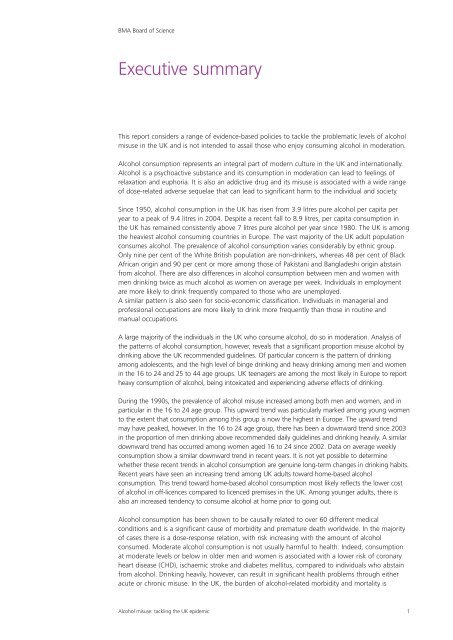Alcohol misuse: tackling the UK epidemic - London
Alcohol misuse: tackling the UK epidemic - London
Alcohol misuse: tackling the UK epidemic - London
Create successful ePaper yourself
Turn your PDF publications into a flip-book with our unique Google optimized e-Paper software.
BMA Board of Science<br />
Executive summary<br />
This report considers a range of evidence-based policies to tackle <strong>the</strong> problematic levels of alcohol<br />
<strong>misuse</strong> in <strong>the</strong> <strong>UK</strong> and is not intended to assail those who enjoy consuming alcohol in moderation.<br />
<strong>Alcohol</strong> consumption represents an integral part of modern culture in <strong>the</strong> <strong>UK</strong> and internationally.<br />
<strong>Alcohol</strong> is a psychoactive substance and its consumption in moderation can lead to feelings of<br />
relaxation and euphoria. It is also an addictive drug and its <strong>misuse</strong> is associated with a wide range<br />
of dose-related adverse sequelae that can lead to significant harm to <strong>the</strong> individual and society.<br />
Since 1950, alcohol consumption in <strong>the</strong> <strong>UK</strong> has risen from 3.9 litres pure alcohol per capita per<br />
year to a peak of 9.4 litres in 2004. Despite a recent fall to 8.9 litres, per capita consumption in<br />
<strong>the</strong> <strong>UK</strong> has remained consistently above 7 litres pure alcohol per year since 1980. The <strong>UK</strong> is among<br />
<strong>the</strong> heaviest alcohol consuming countries in Europe. The vast majority of <strong>the</strong> <strong>UK</strong> adult population<br />
consumes alcohol. The prevalence of alcohol consumption varies considerably by ethnic group.<br />
Only nine per cent of <strong>the</strong> White British population are non-drinkers, whereas 48 per cent of Black<br />
African origin and 90 per cent or more among those of Pakistani and Bangladeshi origin abstain<br />
from alcohol. There are also differences in alcohol consumption between men and women with<br />
men drinking twice as much alcohol as women on average per week. Individuals in employment<br />
are more likely to drink frequently compared to those who are unemployed.<br />
A similar pattern is also seen for socio-economic classification. Individuals in managerial and<br />
professional occupations are more likely to drink more frequently than those in routine and<br />
manual occupations.<br />
A large majority of <strong>the</strong> individuals in <strong>the</strong> <strong>UK</strong> who consume alcohol, do so in moderation. Analysis of<br />
<strong>the</strong> patterns of alcohol consumption, however, reveals that a significant proportion <strong>misuse</strong> alcohol by<br />
drinking above <strong>the</strong> <strong>UK</strong> recommended guidelines. Of particular concern is <strong>the</strong> pattern of drinking<br />
among adolescents, and <strong>the</strong> high level of binge drinking and heavy drinking among men and women<br />
in <strong>the</strong> 16 to 24 and 25 to 44 age groups. <strong>UK</strong> teenagers are among <strong>the</strong> most likely in Europe to report<br />
heavy consumption of alcohol, being intoxicated and experiencing adverse effects of drinking.<br />
During <strong>the</strong> 1990s, <strong>the</strong> prevalence of alcohol <strong>misuse</strong> increased among both men and women, and in<br />
particular in <strong>the</strong> 16 to 24 age group. This upward trend was particularly marked among young women<br />
to <strong>the</strong> extent that consumption among this group is now <strong>the</strong> highest in Europe. The upward trend<br />
may have peaked, however. In <strong>the</strong> 16 to 24 age group, <strong>the</strong>re has been a downward trend since 2003<br />
in <strong>the</strong> proportion of men drinking above recommended daily guidelines and drinking heavily. A similar<br />
downward trend has occurred among women aged 16 to 24 since 2002. Data on average weekly<br />
consumption show a similar downward trend in recent years. It is not yet possible to determine<br />
whe<strong>the</strong>r <strong>the</strong>se recent trends in alcohol consumption are genuine long-term changes in drinking habits.<br />
Recent years have seen an increasing trend among <strong>UK</strong> adults toward home-based alcohol<br />
consumption. This trend toward home-based alcohol consumption most likely reflects <strong>the</strong> lower cost<br />
of alcohol in off-licences compared to licenced premises in <strong>the</strong> <strong>UK</strong>. Among younger adults, <strong>the</strong>re is<br />
also an increased tendency to consume alcohol at home prior to going out.<br />
<strong>Alcohol</strong> consumption has been shown to be causally related to over 60 different medical<br />
conditions and is a significant cause of morbidity and premature death worldwide. In <strong>the</strong> majority<br />
of cases <strong>the</strong>re is a dose-response relation, with risk increasing with <strong>the</strong> amount of alcohol<br />
consumed. Moderate alcohol consumption is not usually harmful to health. Indeed, consumption<br />
at moderate levels or below in older men and women is associated with a lower risk of coronary<br />
heart disease (CHD), ischaemic stroke and diabetes mellitus, compared to individuals who abstain<br />
from alcohol. Drinking heavily, however, can result in significant health problems through ei<strong>the</strong>r<br />
acute or chronic <strong>misuse</strong>. In <strong>the</strong> <strong>UK</strong>, <strong>the</strong> burden of alcohol-related morbidity and mortality is<br />
<strong>Alcohol</strong> <strong>misuse</strong>: <strong>tackling</strong> <strong>the</strong> <strong>UK</strong> <strong>epidemic</strong> 1
















